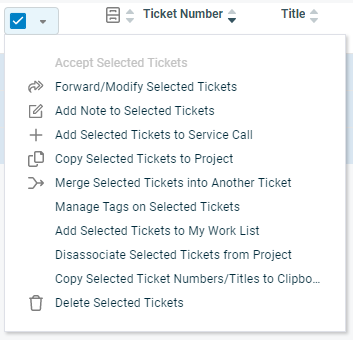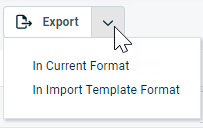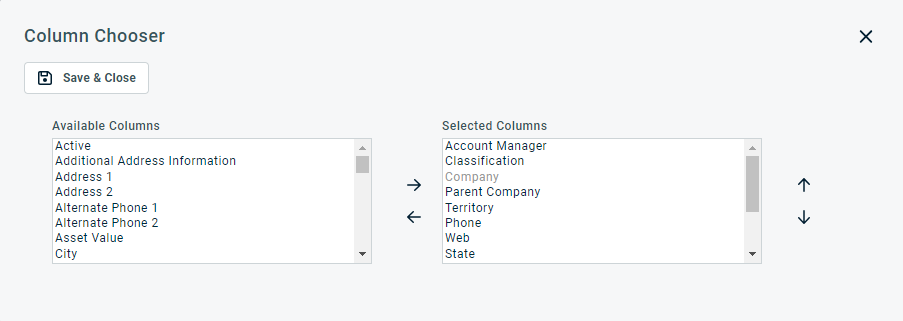Searching and managing tickets
PERMISSIONS These pages are governed by the Service Desk security settings of the security level assigned to you.
• Access to all search pages and features requires the security level permission Can view Ticket Search.
• As a general rule, if your Ticket: view permission is None, ticket navigation links and buttons are hidden from you entirely.
• If your Ticket: view permission is Mine, right-click menus are not available for tickets you cannot view.
NAVIGATION My > Service Desk > (Open Tickets, Overdue Tickets, Submitted Tickets, Closed Tickets)
NAVIGATION My > Service Desk > Workspace & Queues
NAVIGATION Left Navigation Menu > Service Desk > Search > Tickets
NAVIGATION Left Navigation Menu > Service Desk > View > My Workspace & Queues
NAVIGATION Left Navigation Menu > CRM > Search > Organizations > click Search > click an organization name > accessory tabs> Tickets
NAVIGATION Left Navigation Menu > CRM > Search > Opportunities > open an opportunity > accessory tabs > Tickets
NAVIGATION Left Navigation Menu > Contracts > Search > Contracts > open a contract > Menu > > Tickets
NAVIGATION Dashboard > drill into any ticket widget
Searching for tickets
Ticket lists and tables appear in various places throughout Autotask and are also accessed by drilling into any dashboard widget associated with the Ticket entity. To open the page, use the path(s) in the Security and navigation section above.
- To search all tickets, you can use the main Autotask search in the top navigation bar. Refer to Search.
- The Service Desk > Ticket Search page also provides access to all tickets in your Autotask instance. On this page, you can choose the ticket fields you want to use to filter the tickets. Dozens of System and User-Defined Fields are available, making this an extremely powerful search tool. Refer to Searching and managing tickets.
- For quick access to any tickets that are assigned to you and any queues you are assigned to monitor, navigate to the My > Workspace and Queues page. Refer to The My Workspace & Queues page.
- You can also see a list of all tickets assigned to you by navigating to Left Navigation Menu > Home > Reports > My Tickets.
- If you are working on both tickets and projects tasks and want to monitor all your assignments on one page, take a look at the My > Tasks and Tickets page. You can apply additional filters to tasks and tickets, and separate tabs on this page display your to-dos, Service Calls and Change Approvals. Refer to The My Workspace page.
- For convenient access to the tickets you are currently working on, you can set aside up to 25 tickets on the ticket work list. You can continue to run the stopwatch on tickets in the work list. Refer to Using work lists.
- Tickets associated with organizations, opportunities, contracts and projects can be accessed from a Tickets view, tab, or context menu option on the entity.
- On Service Desk dashboard tabs, you can click a number of different areas in a widget, including data points, segments, legends, and totals, to drill into a table list of the items related to that area of the widget. The table lists that you drill into from a widget provide many of the features found in Autotask search result tables. Refer to Click in a widget to open a list of related items and Manage items from the widget drill in grids.
Search page features
- To display a list of all records of a given entity in your Autotask instance, click Search without applying any filters.
Search results containing more than 25, 50, or 100 records (depending on your Records per page setting) are paginated. Use page navigation to view additional results. At most, 5,000 data record will be retrieved at any one time.
- To search for specific records, apply one or more search filters. Refer to Applying a search filter.
The Active filter defaults to Active on the Organization Search, Contact Search, My Organizations, and My Contacts pages, as well as on the global Search by Organization, Contact (First Name), Contact (Last Name), and Contact (Email). The counters in the My menu also reflect only active entities.
NOTE There are several options for phone number filters. The Phone filter will look for a contains match that includes any characters (such as - or () ) entered in the filter box. The Organization Search and Contact Search pages have a Phone (numbers only) option that will ignore special characters in the filter and the results. It will do a contains search for just the numbers entered in the filter box. The Contact Search page also allows you to do a Phone (Starts With) search. It will search for phone numbers that start with the value entered in the filter box.
- To easily limit search results to open tickets (that is, status is not Complete), use the Open (Status not Complete) check box, available from the Filter Chooser.
- To limit search results based on content of the ticket, filter by tag.
- When searching tickets, the Parent Organization filter returns only the tickets created for the sub-organizations of the selected parent account. It does not return the selected parent's tickets. To return all tickets for a parent account and all its sub-organizations, select the parent organization in the Organization filter and select the Show sub-organization items check box located below the Organization filter.
- To search for tickets with inactive tags, on the search field tag selector use the column chooser to add the Active column as a filter.
The following tool buttons appear above the results list:
| Tool Button | Description | ||||||
|---|---|---|---|---|---|---|---|
|
|
Many Search pages (but not the widget drill-down tables) allow you to create a new instance of the selected entity. This button is visible before you execute a search:
For help with populating the fields, refer to the context-sensitive Help of the page that opens. |
||||||
|
|
PERMISSIONS By default, Export is available to users with Admin security level, and disabled for all others. It can be enabled for other security levels. Refer to Can export Grid Data. NOTE When exporting to CSV: To ensure consistent date/time formatting in the CSV output, we strongly recommend that the user’s date/time format settings in Autotask be identical to the Windows date/time format settings of the computer performing the export. This will prevent conflicts in how the software that generates the report interprets the date/time format. IMPORTANT Fields related to billing products for devices and contacts will not be exported.
NOTE Only the first 5,000 records will be exported. |
||||||
|
|
The Column Chooser allows you to customize search results tables throughout Autotask. It determines the following:
NOTE Column Chooser settings on search results tables and some standard reports are part of the user settings stored on the Autotask server. You can log in from any computer and have your column chooser settings applied to your Autotask session. To clear the data stored in your Autotask instance and reset the column chooser settings to the Autotask default settings, click Reset Settings in My > Miscellaneous > Settings. To customize the table, do the following:
Columns appear either in the Available Columns or the Selected Columns panel.
NOTE Top-to-bottom order in the Selected Columns list becomes left-to-right order on the Search Results list.
TIP If the characters + # appear after the column name, then that column may have multiple items returned for some rows. If that occurs, the first item will appear in the row followed by + and the number of additional items returned. To display the list of additional items, hover over the item in the column. Using the column chooser, you are able to display two columns that don't show up on the Device page:
Both fields are available as filters on device widgets, and for the date field, the usual date grouping options are available. For a list of events that count as Last Activity on a device, refer to On a device. |
||||||
|
|
Click the refresh icon |
- To manage a single ticket in a table with a context menu column (for example, widget drill-in tables), point to the menu icon
 to display the menu options. Or, to manage multiple tickets, click the down arrow in the check box column header to display the menu options for multiple tickets.
to display the menu options. Or, to manage multiple tickets, click the down arrow in the check box column header to display the menu options for multiple tickets.
- The available options depend on your security level, whether or not tickets are selected in the table, and which ticket table you are viewing.
| Context / Bulk Menu Option | Description |
|---|---|
| View | |
| Ticket Detail | Opens the Ticket page. Refer to The Ticket page. |
| Ticket History | Opens the Ticket History page to the Ticket History tab. Refer to Viewing the ticket history. |
|
SLA Information |
Opens the Ticket History page to the Service Level Agreement tab. Refer to The Service Level Agreement tab. |
| Organization Service Details | Opens a list of the last 10 time entries against tickets for this customer. Refer to Viewing the Organization Service Details. |
| To-Go Report | Opens a report of ticket details and provides a printout that can be taken on-site. Refer to To Go report. |
| Add | |
| Time Entry | Click to open the Time Entry page. Refer to Adding a ticket time entry. |
| Enter Time for Service Call | When you click this option, the New Ticket (or Task) Time Entry page will open in a new window. The entries for the Date, Start Time, and End Time fields will default to the Start Date, Start Time, and End Time field entries on the service call, and the time entry's Summary Notes field content will default to the service call Description field entry. |
| Note / Add Note to Selected Tickets | Opens the New Ticket Note page. Refer to Adding a note to a task or ticket. |
| Service Call / Add Selected Tickets to Service Call | Allows user to add the ticket to an existing service call or to create a new service call and add the ticket. Refer to Creating and managing service calls from a task or ticket. |
| Ticket Actions | |
| Edit Ticket | Select to edit ticket information. For a description of individual ticket fields, refer to Adding, copying, and editing tickets. NOTE Only users with the required permissions can edit tickets. |
| Edit Recurring Ticket Template (recurring tickets only) | Select to edit the recurring ticket template. Refer to Recurring tickets. |
| Forward/Modify Ticket / Forward/Modify Selected Tickets | Allows users with Ticket View permission = All to forward tickets to other users, or to a queue. Refer to Forwarding and modifying tickets. TIP To update the ticket list after you forward/modify a ticket, click the Refresh button. |
| Accept Ticket / Accept Selected Tickets | When you select Accept Ticket, the ticket is moved from the queue to your Workspace. It is no longer listed in Unassigned Tickets queues. You can instead Accept Ticket and Enter Time in one step, in which case the Time Entry page is displayed. Refer to Use shortcuts to accept tickets. NOTE Accept options are only available if the ticket is not yet assigned. |
| Accept and Enter Time | Assigns the ticket to you and opens the time entry page at the same time. |
| Copy | Opens the New Ticket window, with the following fields copied to the New Ticket page: Organization, Contact, Source, Title, Description, Status, Priority, SLA, Ticket Type, Issue Type, Sub-Issue Type, Estimated Hours, Queue, Primary Resource and Role, Secondary Resources, Work Type, Purchase Order Number, Devices, Additional Devices, User-Defined Fields, and Resolution. This feature is most useful when working with incident tickets. |
| Copy to Project / Copy Selected Tickets to Project | Allows users with access to the Projects module to copy tickets into a project. Refer to Copying a ticket to a project. |
| Merge into Another Ticket / Merge Selected Tickets into Another Ticket | Click to open the data selector. It includes all tickets for the current ticket's organization, excluding Problem and Change Request tickets. Select the ticket to merge into and then Save & Close. Review the message and click Merge or Do Not Merge. Refer to Merging tickets. Permission to edit tickets is required. |
| Manage Tags on Selected Tickets (bulk menu only) | Select this option to open the Manage Tags dialog box, where you will have the option to add new tags to, or remove existing tags from, the selected tickets. You can add a maximum of 30 tags to a ticket. Your level of Service Desk security settings to manage tags will determine the actions available to you. |
| Absorb Other Ticket(s) | Click to open the data selector. It includes all tickets for the current ticket's organization, excluding Problem and Change Request tickets. Select the ticket(s) to absorb and then Save & Close. Review the message and click Absorb or Do Not Absorb. Refer to Merging tickets. Permission to edit tickets is required. |
| Add to My Work List / Add Selected Tickets to my Work List | Allows you to add the ticket or selected tickets to your Work List. Refer to Using work lists. |
| Add to Primary Resource's Work List | Allows you to add the ticket to the primary resource's Work List. Refer to Using work lists. |
| Add to Other Resources' Work List | Allows you to add the ticket to the Work List of one or more additional resources. This option opens a resource selector populated with all active resources. You can select one or more resources. Refer to Using work lists. |
| Disassociate from Project / Disassociate Selected Tickets from Project | Only enabled if the ticket is associated with a project. Allows you to break the association between the ticket and the project. |
| Disassociate from Opportunity | Only enabled if the ticket is associated with an opportunity. Allows you to break the association between the ticket and the opportunity. Accessible from the context menu in a table. |
| Select All on Board (board bulk menu only) | Select this option to select all cards (tickets) on the main board. This will not include cards in the On Deck section. Refer to Using Boards. |
| Select All Not in Dataset (board bulk menu only) | Select this option to select any cards (tickets) that were moved from the On Deck section to the main board. Refer to Using Boards. |
| Clear Board Selections (board bulk menu only) | Select this option to clear any selections from cards on the board. Refer to Using Boards. |
| Delete Ticket / Delete Selected Tickets | Available to Administrators for all tickets and other users for their own tickets, unless the ticket has dependent entities. Refer to Deleting a ticket. |
| Copy to Clipboard | |
|
Ticket Number & Title / Copy Selected Ticket Numbers/Titles to Clipboard |
Copy the selected ticket numbers and titles to the clipboard. |
|
Ticket Number |
Copy the selected ticket numbers to the clipboard. |
|
Ticket URL (Link) |
Copy the URL (link) of the ticket to the clipboard. |
|
Other menus |
|
| Datto RMM | You will see this sub-menu only if the Datto RMM Integration is enabled for you. It allows access to Datto RMM tools for tickets that have a Datto RMM Alert ID. Refer to The Advanced Datto RMM Integration and to Using Datto RMM and BCDR tools from Autotask. It will be disabled if the ticket does not have a Datto RMM Alert ID. |
| Datto | You will see this sub-menu only if the Advanced Datto Integration is enabled for you. It allows access to Datto links for tickets and devices that have a Datto Alert ID. Refer to The Advanced Datto BCDR Integration and to Using Datto RMM and BCDR tools from Autotask. It will be disabled if the device does not have a Datto Device mapped to it. |
| LiveLinks | Refer to LiveLinks for more information on this topic. |





